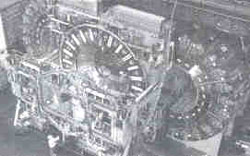Collision course
 PARTICLE accelerators, like the one At fermilab in Illinois, us, have been invaluable Tools in our quest for understanding the nature of the microcosm, e accelerators smash particles her, by analysing the resultant ris', one can gain valuable insights he structure of matter. The higher mergy with which the particles 1c. the better are our chances of "seeing" the microscopic world (Science, vol 269. August 18, 1995).
PARTICLE accelerators, like the one At fermilab in Illinois, us, have been invaluable Tools in our quest for understanding the nature of the microcosm, e accelerators smash particles her, by analysing the resultant ris', one can gain valuable insights he structure of matter. The higher mergy with which the particles 1c. the better are our chances of "seeing" the microscopic world (Science, vol 269. August 18, 1995).
In these atom smashers", usually The particles crash head-on and are broken up. There are however, some re events where a glancing blow no the particles is enough to break w particle, while other escapes shed. These collision is, termed soft Jiogu, have puzled physicists for a time To explain r cvtnM a hypothetoical particle called pomeron was doced in the The surviving de in the collission was thought to emit a pomeron,which breaks up the over particle.
There was however a snag in the theory there was no experimental evidence of the existence Kb a particle! To make matters e. the success of Quantum modynamics (Qrii) in explaining a of experimental data in the '70s ad the porneron idea into the background. The QED came to be accepted as mAmnental theory of strong interactions. @L In W, our current understanding of the microcosmic universe - ioned in the so called standard A of particle physics - is based on lactroweak theory of Weinberg, and Glashow as well as the QCD (see Down To Earth, Vol 3, No 9).
However, though the QCD has been successful in explaining violent collisions between particles, the soft collisions - or diffractive scattering - have eluded its scope. The reason for this is that the equations Of QCD are difficult to solve. Hence what is used is an approxi- mation scheme - called perturbation theory - which is only valid for hard processes because of the nature of the theory itself.
Recent results from DESY, the Harnburg-based German high energy facility, have provided valuable hints as to what the structure of the porneron may be like. The pomeron, since it mediates a collision through a strong nuclear force, must itself be a conglomeration of the fundamental entities in Qcu, i.e., the quarks and the force carriers called gluons. The first results from the HERA accelerator at DESY suggest that the pomeron is mostly gluons and has a small quark component.
The search for pomerons was rejuvenated in the mid-80s when an experiment was conducted at the European Organisation for Nuclear Research (CERN), near Geneva, to study difiractive processes. Colliding protons and antiprotons in the UA8 experiment (conducted at CERN) had a small fraction of diffractive scattering events in which one of the particles escaped unharmed. The data emanating from these processes was found consistent with the pomeron hypothesis, but gave few clues to the structure of pomerons themselves.
The HERA experiment was different from the UA9 because here the collisions were between protons and electrons. Since the electron does not feel the strong force, it can only interact electromagnetically with the proton resulting in a much cleaner process than proton-antiproton collision. Using the HI and Zeus detectors, researchers looked for processes in which the proton emits a pomeron, which interacts with a photon emitted by the electron, resulting in a jet of particles (the proton in this case goes away intact but with a lower energy). Studying this particlejet coming from the breakup of the porneron, scientists have deduced that made the porneron is up of point like particles.
The HERA results have caused a lot of excitement in the particle physics com- munity. The theorists have gone back to their calculations to explain the results while the experimentalists are planning new experiments to study the process further. One such experiment planned is at HERA itself where researchers hope to study glancing collisions between electrons and protons. These will provide more information on the relative contributions of gluons and quarks to the composition of the pomeron.
Related Content
- Order of the Madras High Court regarding regarding compensation to persons affected by oil spillage due to collision of ships Kamarajar Port, Chennai on 28/01/2017
- Balearics launch pioneering plan to phase out emissions
- Why the automobile has no future: a global impact analysis
- Burning land, burning the climate: the biofuel industry's capture of EU bioenergy policy
- Green Activists, Realtors On Collision Course Over Environmental Clearances
- Historical biogeography resolves the origins of endemic Arabian toad lineages (Anura: Bufonidae): Evidence for ancient vicariance and dispersal events with the Horn of Africa and South Asia
